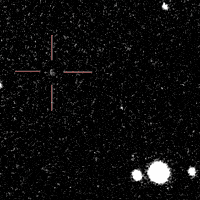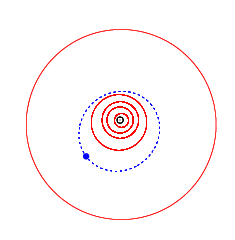Related Research Articles
51827 Laurelclark (provisional designation 2001 OH38) is a background asteroid from the outer regions of the asteroid belt, approximately 6 kilometers in diameter. It was discovered on 20 July 2001, by astronomers of the Near-Earth Asteroid Tracking program at Palomar Observatory in California, United States. The asteroid was named for astronaut Laurel Clark, who died in the Space Shuttle Columbia disaster.

7167 Laupheim, provisional designation 1985 TD3, is a dark background asteroid from the outer regions of the asteroid belt, approximately 20 kilometers (12 miles) in diameter. It was discovered on 12 October 1985, by American astronomers Carolyn and Eugene Shoemaker at the Palomar Observatory in California. The presumed C-type asteroid has a rotation period of 7.04 hours and was named for Robert Clausen and his team at the public Laupheim Observatory in Germany.

9994 Grotius, provisional designation 4028 P-L, is a stony Rafita asteroid from the middle regions of the asteroid belt, approximately 3.5 kilometers in diameter. It was discovered during the Palomar–Leiden survey in 1960, and named after Dutch jurist Hugo Grotius.

9963 Sandage, provisional designation 1992 AN, is a stony Phocaea asteroid from the inner regions of the asteroid belt, approximately 6 kilometers in diameter.

9921 Rubincam, provisional designation 1981 EO18, is a stony asteroid from the inner regions of the asteroid belt, approximately 4 kilometers in diameter. It was discovered on 2 March 1981, by American astronomer Schelte Bus at the Siding Spring Observatory in Australia, and later named after American geophysicist David Rubincam.
5677 Aberdonia, provisional designation 1987 SQ1, is a stony Koronis asteroid from the outer region of the asteroid belt, approximately 8 kilometers in diameter. It was discovered on 21 September 1987, by American astronomer Edward Bowell at Lowell's Anderson Mesa Station in Flagstaff, Arizona, United States. The asteroid was named for the Scottish University of Aberdeen.

6522 Aci is an elongated Phocaea asteroid from the inner regions of the asteroid belt. It was discovered on 9 July 1991, by American astronomer Eleanor Helin at Palomar Observatory in California, United States. The likely stony S-type asteroid has a rotation period of 5.65 hours and measures approximately 6 kilometers in diameter. It was named for the Jaci river at Acireale in Italy, and refers to the myth of Acis and Galatea.
24626 Astrowizard (provisional designation 1980 TS3) is a dark background asteroid from the central regions of the asteroid belt, approximately 7 kilometers in diameter. It was discovered on 9 October 1980, by American astronomer couple Carolyn and Eugene Shoemaker at the Palomar Observatory in California, United States. The asteroid was named for American science educator David Rodrigues, who would perform at public events as "The Astro Wizard".
1846 Bengt, provisional designation 6553 P-L, is a dark asteroid from the inner regions of the asteroid belt, approximately 11 kilometers in diameter. Discovered by the Palomar–Leiden survey in 1960, it was named for Danish astronomer Bengt Strömgren.
3936 Elst, provisional designation 2321 T-3, is a stony Vestian asteroid from the inner regions of the asteroid belt, approximately 5 kilometers in diameter. The asteroid was discovered on 16 October 1977, by Dutch astronomer couple Ingrid and Cornelis van Houten at Leiden, on photographic plates taken by Dutch–American astronomer Tom Gehrels at Palomar Observatory in California, United States. It was named after Belgian astronomer Eric W. Elst.
5391 Emmons, provisional designation 1985 RE2, is a background asteroid from the inner regions of the asteroid belt, approximately 6 kilometers (4 miles) in diameter. It was discovered on 13 September 1985, by American astronomer Eleanor Helin at the Palomar Observatory. The likely S-type asteroid has a rotation period of 3.0 hours. It was named for American astronomer Richard Emmons.
5256 Farquhar, provisional designation 1988 NN, is a stony Eunomian asteroid from the middle regions of the asteroid belt, approximately 12 kilometers in diameter. It was discovered on 11 July 1988, by American astronomers Eleanor Helin, Celina Mikolajczak and Robert Coker at the Palomar Observatory in California. The asteroid was later named for American NASA specialist Robert W. Farquhar.
14789 GAISh, provisional designation 1969 TY1, is a dark background asteroid from the outer regions of the asteroid belt, approximately 15 kilometers (9 miles) in diameter. It was discovered on 8 October 1969, by Soviet astronomer Lyudmila Chernykh of the Crimean Astrophysical Observatory at Nauchnij, on the Crimean peninsula. The assumed C-type asteroid has a rotation period of 8.1 hours and possibly an elongated shape. It was named for the Russian Sternberg Astronomical Institute (GAISh) of Moscow State University.
2143 Jimarnold, provisional designation 1973 SA, is a background asteroid from the inner regions of the asteroid belt, approximately 5 kilometers in diameter. It was discovered on 26 September 1973, by astronomer Eleanor Helin at the Palomar Observatory in California, United States. The asteroid was named after American cosmochemist, James R. Arnold.
7476 Ogilsbie, provisional designation 1993 GE, is a carbonaceous asteroid from the outer region of the asteroid belt, approximately 20 kilometers in diameter. It was discovered by American astronomer Timothy Spahr at the U.S. Catalina Station in Tucson, Arizona, on 14 April 1993.

5208 Royer (prov. designation: 1989 CH1) is a stony Marian asteroid from the central regions of the asteroid belt, approximately 8 kilometers (5 miles) in diameter. It was discovered on 6 February 1989, by astronomer Eleanor Helin at the Palomar Observatory. The S-type asteroid has a rotation period of 3.87 hours and was named after American priest and amateur astronomer, Ronald Royer.
3201 Sijthoff, provisional designation 6560 P-L, is a background or Florian asteroid from the inner regions of the asteroid belt, approximately 5 kilometers in diameter. It was discovered during the Palomar–Leiden survey on 24 September 1960, by Ingrid and Cornelis van Houten at Leiden, and Tom Gehrels at Palomar Observatory in California, United States. The assumed S-type asteroid has a rotation period of 4.607 hours. It was named after Dutch publisher and popularizer of astronomy, Albert Georg Sijthoff.
6181 Bobweber, provisional designation 1986 RW, is a stony asteroid from the inner regions of the asteroid belt, approximately 5 kilometers in diameter. It was discovered on 6 September 1986, by American astronomer Eleanor Helin at the U.S. Palomar Observatory in California, and named after astronomer Robert Weber.
8026 Johnmckay, provisional designation 1991 JA1, is a binary Hungaria asteroid and very slow rotator from the inner regions of the asteroid belt, approximately 2 kilometers in diameter. It was discovered on 8 May 1991, by American astronomer Eleanor Helin at the U.S. Palomar Observatory, California, and later named for NASA test pilot John B. McKay.
14436 Morishita, provisional designation 1992 FC2, is a stony background asteroid and exceptionally slow rotator from the middle region of the asteroid belt, approximately 5 kilometers in diameter.
References
- 1 2 3 4 5 "JPL Small-Body Database Browser: 4897 Tomhamilton (1987 QD6)" (2017-06-05 last obs.). Jet Propulsion Laboratory . Retrieved 4 August 2017.
- 1 2 3 "4897 Tomhamilton (1987 QD6)". Minor Planet Center. Retrieved 26 August 2016.
- 1 2 3 Masiero, Joseph R.; Mainzer, A. K.; Grav, T.; Bauer, J. M.; Cutri, R. M.; Dailey, J.; et al. (November 2011). "Main Belt Asteroids with WISE/NEOWISE. I. Preliminary Albedos and Diameters". The Astrophysical Journal. 741 (2): 20. arXiv: 1109.4096 . Bibcode:2011ApJ...741...68M. doi:10.1088/0004-637X/741/2/68 . Retrieved 26 August 2016.
- ↑ "4897 Tomhamilton (1987 QD6)". Minor Planet Center. Retrieved 13 October 2024.
- ↑ "MPC/MPO/MPS Archive". Minor Planet Center. Retrieved 26 August 2016.
- ↑ "LCDB Data for (4897) Tomhamilton". Asteroid Lightcurve Database (LCDB). Retrieved 4 August 2017.